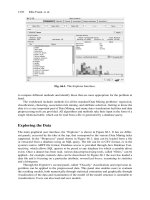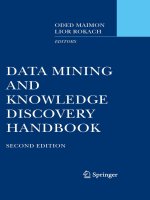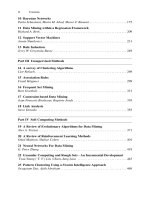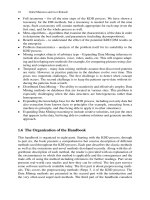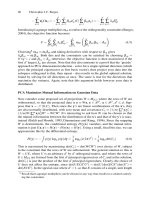Data Mining and Knowledge Discovery Handbook, 2 Edition part 3 pptx
Bạn đang xem bản rút gọn của tài liệu. Xem và tải ngay bản đầy đủ của tài liệu tại đây (495.66 KB, 10 trang )
XX List of Contributors
Evgenii Vityaev
Institute of Mathematics,
Russian Academy of Sciences, Russia
Michail Vlachos
IBM T. J. Watson Research Center,
USA
Ioannis Vlahavas
Dept. of Informatics, Aristotle Univer-
sity of Thessaloniki, 54124 Greece
Haixun Wang
IBM T. J. Watson Research Center,
USA
Wei Wang
Department of Computer Science,
University of North Carolina at Chapel
Hill, USA
Geoffrey I. Webb
Faculty of Information Technology,
Monash University, Australia
Gary M. Weiss
Department of Computer and Informa-
tion Science,
Fordham University, USA
Ian H. Witten
Department of Computer Science,
University of Waikato, New Zealand
Jacob Zahavi
The Wharton School,
University of Pennsylvania, USA
Arkady Zaslavsky
Centre for Distributed Systems and
Software Engineering
Monash University
Peter G. Zhang
Department of Managerial Sciences,
Georgia State University, USA
Pusheng Zhang
Department of Computer Science and
Engineering,
University of Minnesota, USA
Qingyu Zhang
Arkansas State University, Department
of
Computer and Info. Tech.,
Jonesboro, AR 72467-0130,USA
Ruofei Zhang
Yahoo!, Inc. Sunnyvale, CA 94089
Zhongfei (Mark) Zhang
SUNY Binghamton, NY 13902-6000
Bla
ˇ
z Zupan
Faculty of Computer and Information
Science,
University of Ljubljana, Slovenia
1
Introduction to Knowledge Discovery and Data
Mining
Oded Maimon
1
and Lior Rokach
2
1
Department of Industrial Engineering, Tel-Aviv University, Ramat-Aviv 69978, Israel,
2
Department of Information System Engineering, Ben-Gurion University, Beer-Sheba,
Israel,
Knowledge Discovery in Databases (KDD) is an automatic, exploratory analysis and
modeling of large data repositories. KDD is the organized process of identifying
valid, novel, useful, and understandable patterns from large and complex data sets.
Data Mining (DM) is the core of the KDD process, involving the inferring of algo-
rithms that explore the data, develop the model and discover previously unknown
patterns. The model is used for understanding phenomena from the data, analysis
and prediction.
The accessibility and abundance of data today makes Knowledge Discovery and
Data Mining a matter of considerable importance and necessity. Given the recent
growth of the field, it is not surprising that a wide variety of methods is now avail-
able to the researchers and practitioners. No one method is superior to others for all
cases. The handbook of Data Mining and Knowledge Discovery from Data aims to
organize all significant methods developed in the field into a coherent and unified
catalog; presents performance evaluation approaches and techniques; and explains
with cases and software tools the use of the different methods. The goals of this in-
troductory chapter are to explain the KDD process, and to position DM within the
information technology tiers. Research and development challenges for the next gen-
eration of the science of KDD and DM are also defined. The rationale, reasoning and
organization of the handbook are presented in this chapter for helping the reader to
navigate the extremely rich and detailed content provided in this handbook. In this
chapter there are six sections followed by a brief discussion of the changes in the
second edition.
1. The KDD Process 2. Taxonomy of Data Mining Methods 3. Data Mining within
the Complete Decision Support System 4. KDD & DM Research Opportunities and
Challenges 5. KDD & DM Trends 6. The Organization of the Handbook 7. New to
This Edition
The special recent aspects of data availability that are promoting the rapid develop-
ment of KDD and DM are the electronically readiness of data (though of different
types and reliability). The internet and intranet fast development in particular pro-
O. Maimon, L. Rokach (eds.), Data Mining and Knowledge Discovery Handbook, 2nd ed.,
DOI 10.1007/978-0-387-09823-4_1, © Springer Science+Business Media, LLC 2010
2 Oded Maimon and Lior Rokach
mote data accessibility (as formatted or unformatted, voice or video, etc.). Methods
that were developed before the Internet revolution considered smaller amounts of
data with less variability in data types and reliability. Since the information age, the
accumulation of data has become easier and less costly. It has been estimated that
the amount of stored information doubles every twenty months. Unfortunately, as
the amount of electronically stored information increases, the ability to understand
and make use of it does not keep pace with its growth. Data Mining is a term coined
to describe the process of sifting through large databases for interesting patterns and
relationships. The studies today aim at evidence-based modeling and analysis, as is
the leading practice in medicine, finance, security and many other fields. The data
availability is increasing exponentially, while the human processing level is almost
constant. Thus the potential gap increases exponentially. This gap is the opportunity
for the KDD\DM field, which therefore becomes increasingly important and neces-
sary.
1.1 The KDD Process
The knowledge discovery process (Figure 1.1) is iterative and interactive, consisting
of nine steps. Note that the process is iterative at each step, meaning that moving
back to adjust previous steps may be required. The process has many “artistic” as-
pects in the sense that one cannot present one formula or make a complete taxonomy
for the right choices for each step and application type. Thus it is required to deeply
understand the process and the different needs and possibilities in each step. Taxon-
omy for the Data Mining methods is helping in this process. It is presented in the
next section.
The process starts with determining the KDD goals, and “ends” with the imple-
mentation of the discovered knowledge. As a result, changes would have to be made
in the application domain (such as offering different features to mobile phone users
in order to reduce churning). This closes the loop, and the effects are then measured
on the new data repositories, and the KDD process is launched again. Following is a
brief description of the nine-step KDD process, starting with a managerial step:
1. Developing an understanding of the application domain This is the initial
preparatory step. It prepares the scene for understanding what should be done
with the many decisions (about transformation, algorithms, representation, etc.).
The people who are in charge of a KDD project need to understand and define
the goals of the end-user and the environment in which the knowledge discovery
process will take place (including relevant prior knowledge). As the KDD
process proceeds, there may be even a revision and tuning of this step. Having
understood the KDD goals, the preprocessing of the data starts, as defined in the
next three steps (note that some of the methods here are similar to Data Mining
algorithms, but are used in the preprocessing context):
2. Selecting and creating a data set on which discovery will be performed. Having
defined the goals, the data that will be used for the knowledge discovery should
1 Introduction to Knowledge Discovery and Data Mining 3
Fig. 1.1. The Process of Knowledge Discovery in Databases.
be determined. This includes finding out what data is available, obtaining
additional necessary data, and then integrating all the data for the knowledge
discovery into one data set, including the attributes that will be considered for
the process. This process is very important because the Data Mining learns and
discovers from the available data. This is the evidence base for constructing the
models. If some important attributes are missing, then the entire study may fail.
From success of the process it is good to consider as many as possible attribute
at this stage. On the other hand, to collect, organize and operate complex data
repositories is expensive, and there is a tradeoff with the opportunity for best
understanding the phenomena. This tradeoff represents an aspect where the
interactive and iterative aspect of the KDD is taking place. It starts with the
best available data set and later expands and observes the effect in terms of
knowledge discovery and modeling.
3. Preprocessing and cleansing. In this stage, data reliability is enhanced. It includes
data clearing, such as handling missing values and removal of noise or outliers.
Several methods are explained in the handbook, from doing nothing to becoming
the major part (in terms of time consumed) of a KDD process in certain projects.
It may involve complex statistical methods, or using specific Data Mining al-
gorithm in this context. For example, if one suspects that a certain attribute is
not reliable enough or has too many missing data, then this attribute could be-
come the goal of a data mining supervised algorithm. A prediction model for
this attribute will be developed, and then missing data can be predicted. The ex-
tension to which one pays attention to this level depends on many factors. In any
case, studying these aspects is important and often revealing insight by itself,
regarding enterprise information systems.
4 Oded Maimon and Lior Rokach
4. Data transformation. In this stage, the generation of better data for the data min-
ing is prepared and developed. Methods here include dimension reduction (such
as feature selection and extraction, and record sampling), and attribute transfor-
mation (such as discretization of numerical attributes and functional transforma-
tion). This step is often crucial for the success of the entire KDD project, but it is
usually very project-specific. For example, in medical examinations, the quotient
of attributes may often be the most important factor, and not each one by itself. In
marketing, we may need to consider effects beyond our control as well as efforts
and temporal issues (such as studying the effect of advertising accumulation).
However, even if we do not use the right transformation at the beginning, we
may obtain a surprising effect that hints to us about the transformation needed
(in the next iteration). Thus the KDD process reflects upon itself and leads to
an understanding of the transformation needed (like a concise knowledge of an
expert in a certain field regarding key leading indicators). Having completed the
above four steps, the following four steps are related to the Data Mining part,
where the focus is on the algorithmic aspects employed for each project:
5. Choosing the appropriate Data Mining task. We are now ready to decide on
which type of Data Mining to use, for example, classification, regression, or clus-
tering. This mostly depends on the KDD goals, and also on the previous steps.
There are two major goals in Data Mining: prediction and description. Prediction
is often referred to as supervised Data Mining, while descriptive Data Mining
includes the unsupervised and visualization aspects of Data Mining. Most data
mining techniques are based on inductive learning, where a model is constructed
explicitly or implicitly by generalizing from a sufficient number of training ex-
amples. The underlying assumption of the inductive approach is that the trained
model is applicable to future cases. The strategy also takes into account the level
of meta-learning for the particular set of available data.
6. Choosing the Data Mining algorithm. Having the strategy, we now decide on the
tactics. This stage includes selecting the specific method to be used for search-
ing patterns (including multiple inducers). For example, in considering preci-
sion versus understandability, the former is better with neural networks, while
the latter is better with decision trees. For each strategy of meta-learning there
are several possibilities of how it can be accomplished. Meta-learning focuses
on explaining what causes a Data Mining algorithm to be successful or not in
a particular problem. Thus, this approach attempts to understand the conditions
under which a Data Mining algorithm is most appropriate. Each algorithm has
parameters and tactics of learning (such as ten-fold cross-validation or another
division for training and testing).
7. Employing the Data Mining algorithm. Finally the implementation of the Data
Mining algorithm is reached. In this step we might need to employ the algo-
rithm several times until a satisfied result is obtained, for instance by tuning the
algorithm’s control parameters, such as the minimum number of instances in a
single leaf of a decision tree.
8. Evaluation. In this stage we evaluate and interpret the mined patterns (rules, reli-
ability etc.), with respect to the goals defined in the first step. Here we consider
1 Introduction to Knowledge Discovery and Data Mining 5
the preprocessing steps with respect to their effect on the Data Mining algorithm
results (for example, adding features in Step 4, and repeating from there). This
step focuses on the comprehensibility and usefulness of the induced model. In
this step the discovered knowledge is also documented for further usage. The
last step is the usage and overall feedback on the patterns and discovery results
obtained by the Data Mining:
9. Using the discovered knowledge. We are now ready to incorporate the knowledge
into another system for further action. The knowledge becomes active in the
sense that we may make changes to the system and measure the effects. Ac-
tually the success of this step determines the effectiveness of the entire KDD
process. There are many challenges in this step, such as loosing the “laboratory
conditions” under which we have operated. For instance, the knowledge was dis-
covered from a certain static snapshot (usually sample) of the data, but now the
data becomes dynamic. Data structures may change (certain attributes become
unavailable), and the data domain may be modified (such as, an attribute may
have a value that was not assumed before).
1.2 Taxonomy of Data Mining Methods
There are many methods of Data Mining used for different purposes and goals. Tax-
onomy is called for to help in understanding the variety of methods, their interrela-
tion and grouping. It is useful to distinguish between two main types of Data Min-
ing: verification-oriented (the system verifies the user’s hypothesis) and discovery-
oriented (the system finds new rules and patterns autonomously). Figure 1.2 presents
this taxonomy.
Discovery methods are those that automatically identify patterns in the data. The
discovery method branch consists of prediction methods versus description meth-
ods. Descriptive methods are oriented to data interpretation, which focuses on un-
derstanding (by visualization for example) the way the underlying data relates to its
parts. Prediction-oriented methods aim to automatically build a behavioral model,
which obtains new and unseen samples and is able to predict values of one or more
variables related to the sample. It also develops patterns, which form the discov-
ered knowledge in a way which is understandable and easy to operate upon. Some
prediction-oriented methods can also help provide understanding of the data.
Most of the discovery-oriented Data Mining techniques (quantitative in partic-
ular) are based on inductive learning, where a model is constructed, explicitly or
implicitly, by generalizing from a sufficient number of training examples. The un-
derlying assumption of the inductive approach is that the trained model is applicable
to future unseen examples.
Verification methods, on the other hand, deal with the evaluation of a hypothesis
proposed by an external source (like an expert etc.). These methods include the most
common methods of traditional statistics, like goodness of fit test, tests of hypothe-
ses (e.g., t-test of means), and analysis of variance (ANOVA). These methods are
less associated with Data Mining than their discovery-oriented counterparts, because
6 Oded Maimon and Lior Rokach
Fig. 1.2. Data Mining Taxonomy.
most Data Mining problems are concerned with discovering an hypothesis (out of a
very large set of hypotheses), rather than testing a known one. Much of the focus of
traditional statistical methods is on model estimation as opposed to one of the main
objectives of Data Mining: model identification and construction, which is evidence
based (though overlap occurs).
Another common terminology, used by the machine-learning community, refers
to the prediction methods as supervised learning, as opposed to unsupervised learn-
ing. Unsupervised learning refers to modeling the distribution of instances in a typi-
cal, high-dimensional input space.
Unsupervised learning refers mostly to techniques that group instances without a
prespecified, dependent attribute. Thus the term “unsupervised learning” covers only
a portion of the description methods presented in Figure 1.2. For instance, it covers
clustering methods but not visualization methods. Supervised methods are methods
that attempt to discover the relationship between input attributes (sometimes called
independent variables) and a target attribute sometimes referred to as a dependent
variable). The relationship discovered is represented in a structure referred to as a
model. Usually models describe and explain phenomena, which are hidden in the
data set and can be used for predicting the value of the target attribute knowing
the values of the input attributes. The supervised methods can be implemented on
a variety of domains, such as marketing, finance and manufacturing. It is useful to
distinguish between two main supervised models: classification models and regres-
sion models. The latter map the input space into a real-valued domain. For instance,
a regressor can predict the demand for a certain product given its characteristics. On
the other hand, classifiers map the input space into predefined classes. For example,
classifiers can be used to classify mortgage consumers as good (fully payback the
1 Introduction to Knowledge Discovery and Data Mining 7
mortgage on time) and bad (delayed payback), or as many target classes as needed.
There are many alternatives to represent classifiers. Typical examples include, sup-
port vector machines, decision trees, probabilistic summaries, or algebraic function.
1.3 Data Mining within the Complete Decision Support System
Data Mining methods are becoming part of integrated Information Technology (IT)
software packages. Figure 1.3 illustrates the three tiers of the decision support aspect
of IT. Starting from the data sources (such as operational databases, semi- and non-
structured data and reports, Internet sites etc.), the first tier is the data warehouse,
followed by OLAP (On Line Analytical Processing) servers and concluding with
analysis tools, where Data Mining tools are the most advanced.
Fig. 1.3. The IT Decision Support Tiers.
The main advantage of the integrated approach is that the preprocessing steps are
much easier and more convenient. Since this part is often the major burden for the
KDD process (and can consumes most of the KDD project time), this industry trend
is very important for expanding the use and utilization of Data Mining. However, the
risk of the integrated IT approach comes from the fact that DM techniques are much
more complex and intricate than OLAP, for example, so the users need to be trained
appropriately.
This handbook shows the variety of strategies, techniques and evaluation mea-
surements. We can naively distinguish among three levels of analysis. The simplest
one is achieved by report generators (for example, presenting all claims that oc-
curred because of a certain cause last year, such as car theft). We then proceed to
OLAP multi-level analysis (for example presenting the ten towns where there was
the highest increase of vehicle theft in the last month as compared to with the month
8 Oded Maimon and Lior Rokach
before). Finally a complex analysis is carried out in discovering the patterns that pre-
dict car thefts in these cities, and what might occur if anti theft devices were installed.
The latter is based on mathematical modeling of the phenomena, where the first two
levels are ways of data aggregation and fast manipulation.
1.4 KDD and DM Research Opportunities and Challenges
Empirical comparison of the performance of different approaches and their variants
in a wide range of application domains has shown that each performs best in some,
but not all, domains. This phenomenon is known as the selective superiority problem,
which means, in our case, that no induction algorithm can be the best in all possible
domains. The reason is that each algorithm contains an explicit or implicit bias that
leads it to prefer certain generalizations over others, and it will be successful only
as long as this bias matches the characteristics of the application domain. Results
have demonstrated the existence and correctness of this “no free lunch theorem”. If
one inducer is better than another in some domains, then there are necessarily other
domains in which this relationship is reversed. This implies in KDD that for a given
problem a certain approach can yield more knowledge from the same data than other
approaches.
In many application domains, the generalization error (on the overall domain,
not just the one spanned in the given data set) of even the best methods is far above
the training set, and the question of whether it can be improved, and if so how, is
an open and important one. Part of the answer to this question is to determine the
minimum error achievable by any classifier in the application domain (known as the
optimal Bayes error). If existing classifiers do not reach this level, new approaches
are needed. Although this problem has received considerable attention, no generally
reliable method has so far been demonstrated. This is one of the challenges of the
DM research – not only to solve it, but even to quantify and understand it better.
Heuristic methods can then be compared absolutely and not just against each other.
A subset of this generalized study is the question of which inducer to use for
a given problem. To be even more specific, the performance measure needs to be
defined appropriately for each problem. Though there are some commonly accepted
measures it is not enough. For example, if the analyst is looking for accuracy only,
one solution is to try each one in turn, and by estimating the generalization error,
to choose the one that appears to perform best. Another approach, known as multi-
strategy learning, attempts to combine two or more different paradigms in a single
algorithm. The dilemma of which method to choose becomes even greater if other
factors, such as comprehensibility are taken into consideration. For instance, for a
specific domain, neural networks may outperform decision trees in accuracy. How-
ever from the comprehensibility aspect, decision trees are considered superior. In
other words, in this case even if the researcher knows that neural network is more ac-
curate, the dilemma of what methods to use still exists (or maybe to combine methods
for their separate strength).
1 Introduction to Knowledge Discovery and Data Mining 9
Induction is one of the central problems in many disciplines such as machine
learning, pattern recognition, and statistics. However the feature that distinguishes
Data Mining from traditional methods is its scalability to very large sets of varied
types of input data. Scalability means working in an environment of high number
of records, high dimensionality, and a high number of classes or heterogeneousness.
Nevertheless, trying to discover knowledge in real life and large databases introduces
time and memory problems. As large databases have become the norm in many fields
(including astronomy, molecular biology, finance, marketing, health care, and many
others), the use of Data Mining to discover patterns in them has become potentially
very beneficial for the enterprise. Many companies are staking a large part of their
future on these “Data Mining” applications, and turn to the research community for
solutions to the fundamental problems they encounter. While a very large amount of
available data used to be the dream of any data analyst, nowadays the synonym for
“very large” has become “terabyte” or “pentabyte”, a barely imaginable volume of
information.
Information-intensive organizations (like telecom companies and financial insti-
tutions) are expected to accumulate several terabytes of raw data every one to two
years. High dimensionality of the input (that is, the number of attributes) increases
the size of the search space in an exponential manner (known as the “Curse of Di-
mensionality”), and thus increases the chance that the inducer will find spurious clas-
sifiers that in general are not valid. There are several approaches for dealing with a
high number of records including: sampling methods, aggregation, massively paral-
lel processing, and efficient storage methods.
1.5 KDD & DM Trends
This handbook covers the current state-of-the-art status of Data Mining. The field is
still in its early stages in the sense that some basic methods are still being developed.
The art expands but so does the understanding and the automation of the nine steps
and their interrelation. For this to happen we need better characterization of the KDD
problem spectrum and definition. The terms KDD and DM are not well-defined in
terms of what methods they contain, what types of problem are best solved by these
methods, and what results to expect. How are KDD\DM compared to statistics, ma-
chine learning, operations research, etc.? If subset or superset of the above fields?
Or an extension\adaptation of them? Or a separate field by itself? In addition to the
methods – which are the most promising fields of application and what is the vi-
sion KDD\DM brings to these fields? Certainly we already see the great results and
achievements of KDD\DM, but we cannot estimate their results with respect to the
potential of this field. All these basic analyses have to be studied and we see several
trends for future research and implementation, including:
• Active DM – closing the loop, as in control theory, where changes to the system
are made according to the KDD results and the full cycle starts again. Stability
and controllability, which will be significantly different in these types of systems,
need to be well-defined.
